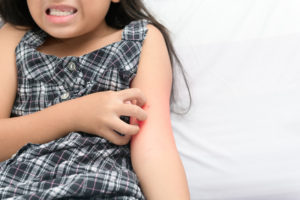Shingles is not exactly an infection…at least not at the time it develops. The infection is actually the chickenpox virus that you had long ago. The chickenpox virus, varicella, never leaves your body. It withdraws into nerve junctions near the brain and spinal cord, and it stays there for years. Then, it reactivates (and is called varicella-zoster) and travels along some of the nerve fibers to the skin where it produces a rash.
What causes the reactivation? No one is certain, but it seems to be related to a decrease in the immune system, usually due to aging. The episode may be set off by physical, mental, or emotional shocks.
Warning Signs of Developing Shingles
1. The most common symptom is tingling, burning, aching, or itching in a patch of skin. There is no rash at this point, just itchiness. At times, there may be stabbing pains in the area. This neuralgia occurs in 70% to 80% of shingles patients.
2. The pain during the prodromal period, which can last from one to ten days, can mimic other types of pain. It has been mistaken for a toothache, a headache, iritis, or pleurisy. When it simulates pain from a heart attack or appendicitis, the potential for harm becomes greater.
3. The area with the abnormal sensations is localized and usually just on one side of the body. The most common sites for this neuralgia are on the face, along the neck, on the back, or across the chest. It can appear on the lower body, but not as frequently. Because the virus follows nerve fibers from the spinal cord up to the skin, it presents in what is called a dermatomal pattern. The rash appears in the area that is innervated by that particular nerve.
4. In addition to the abnormal sensations and pain, the area that is affected may be very sensitive to touch. A soft stroke of a finger can set off pain and tingling.
5. Fever may occur, although it is less common than the neuralgia, showing up in only 20% of patients. The fever is generally mild, but it can be intense, associated with chills. The fever responds to acetaminophen.
6. Generalized malaise, a feeling of overall discomfort, achiness, and fatigue, is sometimes observed in the prodromal period. You feel down, exhausted, and don’t want to do anything except lie down and sleep. You can lose your appetite or even have some nausea. You may think you’re coming down with the flu.
Within a few days of the onset of these symptoms, a redness appears in the area, followed by the development of tiny blisters. The pain may stay the same, or it may increase or decrease. One of the worst problems caused by shingles is post-herpetic neuralgia. This is a pain in the area that can be so intense that it becomes debilitating, lasting for weeks, months, or even years. It’s best to contact your doctor or a pain treatment center if you suspect you think you have shingles.
The shingles vaccine does not necessarily prevent shingles every time, but the vaccine does decrease the severity of the disease and helps to prevent post-herpetic neuralgia. If you haven’t had the shingles vaccine yet, think seriously about getting it now.



